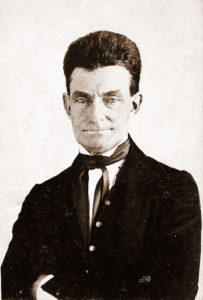
John Brown
This date marks the birth of John Brown in 1800. He was a white-American abolitionist whose attempt to end slavery by force significantly increased anxiety between the North and South before the American Civil War.
Called Old Brown of Osawatomie, John Brown was from Torrington, Connecticut. His family moved to Ohio when he was five years old. His father became actively hostile to the institution of slavery, and so young Brown, early in life, acquired the hatred of slavery that marked his calling. While living in Pennsylvania in 1834, Brown initiated a project among sympathetic abolitionists to educate young Blacks. The following 20 years of his life were primarily dedicated to this and similar abolitionist ventures, entailing many sacrifices for himself and his large family.
In 1855, he followed five sons to Kansas Territory, a center of a struggle between the antislavery and pro-slavery forces. Under Brown's leadership, his sons became active participants in the fight against pro-slavery terrorists from Missouri, whose activities led to the murder of several abolitionists in Lawrence, Kansas. Brown and his sons avenged this crime on May 24, 1856, at Pottawatomie Creek by killing five pro-slavery adherents. This act and his success in withstanding a large party of attacking Missourians at Osawatomie in August made him nationally famous as an irreconcilable foe of slavery.
Aided by increased financial support from abolitionists in the northeastern states, Brown began in 1857 to formulate a plan, which he had long entertained, to free the slaves by armed force. He secretly recruited a small band of supporters for this project, which included the establishment of a refuge for fugitive slaves in the mountains of Virginia. After several setbacks, he launched the venture on October 16, 1859, with 18 men (including several of his sons), seizing the United States arsenal and armory at Harpers Ferry, Virginia, and winning control of the town. After his initial success, he did not attempt offensive action but occupied defensive positions within the area.
The band was surrounded by the local militia, which was reinforced on October 17 by a company of U.S. Marines under the command of Colonel Robert E. Lee. Ten of Brown's men, including two of his sons, were killed, and he was wounded and forced to surrender. He was arrested and charged with various crimes, including treason and murder. He distinguished himself during his trial, which took place before a Virginia court, by the eloquent defense of his efforts on behalf of the slaves. Convicted, he was hanged in Charlestown, Virginia (now West Virginia) on December 16, 1859.
For many years after his death, Brown was regarded as a martyr to the cause of human freedom. He became the subject of a famous song, known generally by the first line as "John Brown's body lies a mold ring in the grave."